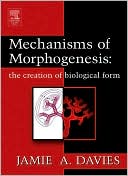Mechanisms of Morphogenesis
Search in google:
Morphogenesis is the set of processes that generate shape and form in the embryo- an important area within developmental biology. An exciting and up to the minute account of the very latest research into the factors that create biological form, Mechanisms of Morphogenesis is a text reference on the mechanisms of cell and tissue morphogenesis in a diverse array of organisms including prokaryotes, animals, plants and fungi. By combining hard data with computer modelling, this book will equip readers with a much broader understanding of the scope of modern research than is otherwise available. The book focuses on the ways in which the genetic programme is translated to generate cell shape, to direct cell migration, and to produce the shape, form and rates of growth of the various tissues. Each topic is illustrated with experimental data from real systems, with particular reference to gaps in current knowledge and pointers to future research.• Includes over 200 four-color figures • Offers an integrated view of theoretical developmental biology and computer modelling with laboratory-based discoveries • Covers experimental techniques as a guide to the reader • Organized around principles and mechanisms, using them to integrate discoveries from a range of organisms and systems Doody Review Services Reviewer:Bruce A. Fenderson, PhD(Thomas Jefferson University)Description:Although we are beginning to understand the genetic control of differentiation and pattern formation, we still do not have a general theory that explains how embryos acquire their form. How do cells translate a "command" to make a shape into the shape itself? What are the forces that shape the embryo? Morphogenesis remains a deep and fascinating developmental question. This beautiful book presents an overview of new concepts in this exciting field. The author asks fundamental questions and provides illustrations based on modern research. The book includes six chapters on topics ranging from mechanisms of cell migration to morphogenesis by cell proliferation and cell death. The primary focus is on cell and developmental biology.Purpose:According to the author, the purpose of this book "is to bring together in one place some of the most significant advances that have been made in identifying mechanisms of morphogenesis from a variety of species and systems." It provides examples of the mechanisms that have been found to drive the morphogenetic events that are common in animal and plant development. This is a noble task because traditional approaches to teaching developmental biology often gloss over the subject of morphogenesis, with hand waving about differential cell adhesion. Audience:The book is written primarily for advanced undergraduates and basic science researchers (graduate students, postdoctoral fellows, scientists) interested in cellular and developmental biology. It would provide an excellent guide for a seminar course. Because the author highlights results from many different species, the book will be appreciated by a wide range of biologists, including those interested in the development of plants and "lower" organisms.Features:This book is carefully edited and a joy to read. Color typography is used for chapter titles and section headers. The color illustrations are beautifully prepared and informative. Many of the illustrations are hand drawn for clarity of presentation, and (as noted by the author) to make this book affordable. Footnotes are provided throughout to explain key points. Each chapter includes an extensive bibliography enabling the reader to gain immediate access to the literature.Assessment:The author provides an excellent blend of theory and experimental biology. The problems faced by the embryo are identified and experimental findings are interpreted. The grand unifying theme is "adaptive self-organization." This is the kind of interpretation and integration of science that is so valuable. It is refreshing to read a book that provides more than just a simple list of isolated facts. It is important to note that this is not a comprehensive textbook in developmental biology. As noted by the author, the book "is not intended to compete with the general texts, which are largely devoted to discussion of differentiation, signaling, and pattern formation." Indeed, the author has largely excluded many fascinating topics that are relevant to embryogenesis, including a discussion of morphogenesis, stem cells, and epithelial-mesenchymal interactions. The book does not provide an evolutionary perspective to embryology. Although the topics are limited, the book is focused, informative, and fun to read. The illustrations are well done and highlight essential concepts. I highly recommend it for biologists, as well as students of biophysics and bioengineering. It provides a great overview of major findings and new paradigms in the study of biological structure and function.
1Introductory section12Cell shape and the cell morphogenesis313Cell migration934Epithelial morphogenesis1975Morphogenesis by cell proliferation and death2896Conclusions and perspectives347







